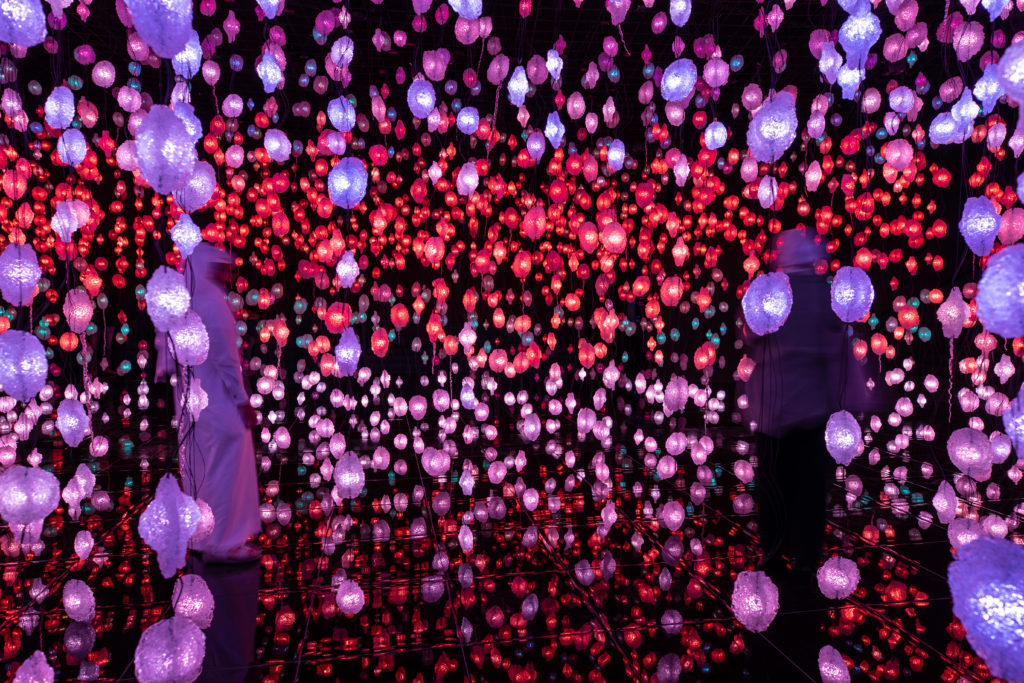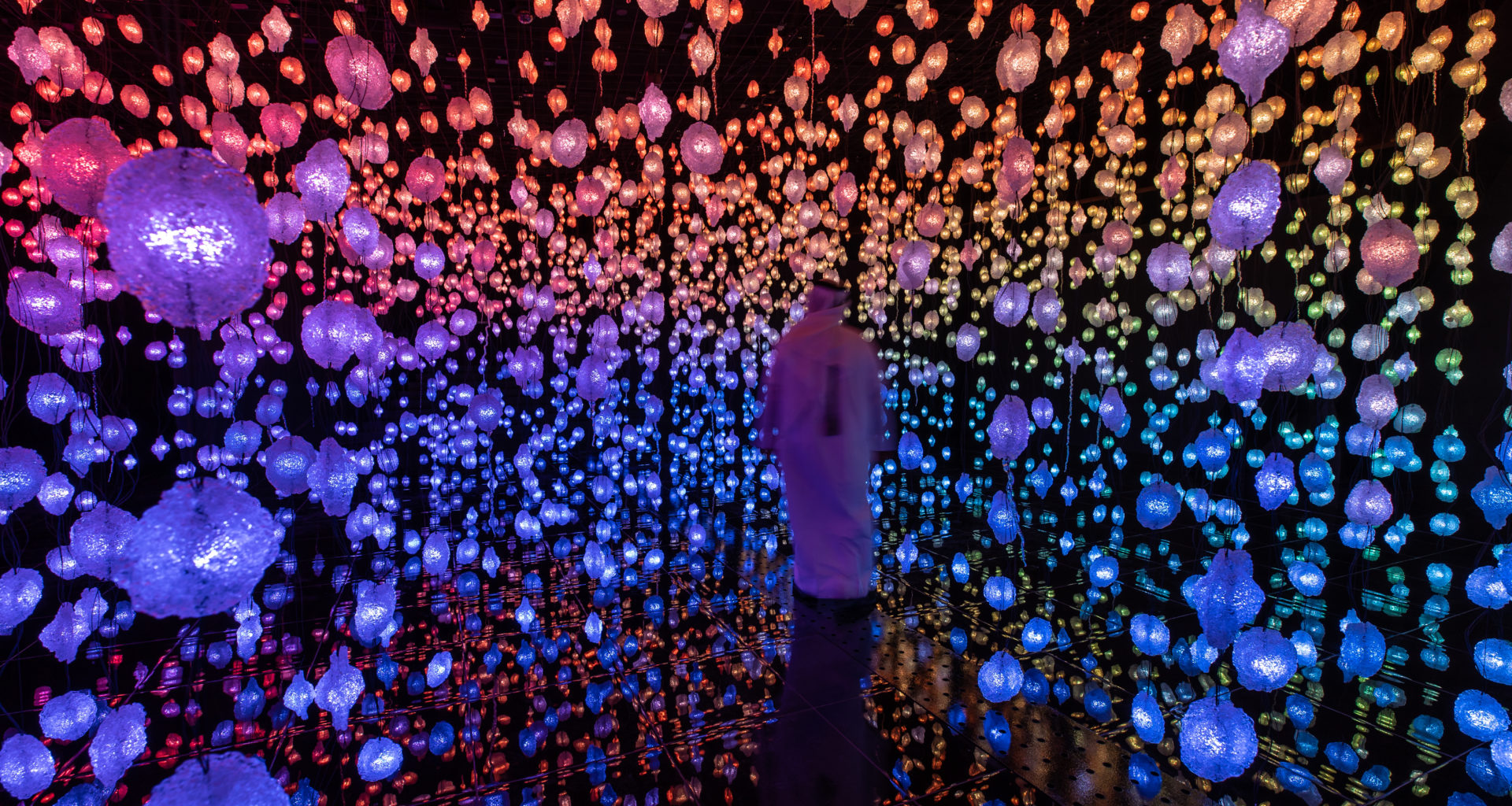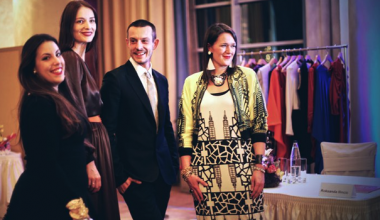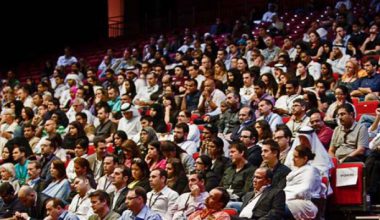National Museum of Qatar (NMoQ), is a vibrant hub that celebrates Qatar's rich heritage and culture. Their exhibition Your Brain to Me, My Brain to You by the award-winning Swiss artist Pipilotti Rist is a site-specific, immersive video installation that invites visitors to embark on a journey of self-discovery.
The formal museum space has been turned into an intimate journey composed of 12,000 led lights strung on cables throughout the gallery. Dubbed as ‘pixels’ they represent neurons, constantly firing and communicating with each other, the pulsing resin-encased bulbs have been programmed in choreography with a soundscape and video installation featuring abstract footage of Qatar’s landscapes. Visitors are encouraged to turn off their devices and focus on being in the present and activating different senses. The exhibition is also a reminder of the importance of self-care, mindfulness and expressing gratitude.
Curated by Tom Eccles and Bouthayna Baltaji, this is Rist’s first exhibition in the region. Khaleejesque, sat down with Bouthayna Baltaji, who is the curator and also serves as Acting Head of Exhibitions Section, to discuss this multifaceted installation and NMoQ’s process behind it.
“ This work is both a collective and individual experience. We want to understand what is happening inside the brain of the other, and culture is the main way to try to understand each other beyond language. “ – Pipilotti Rist.

Saira Malik (S.M.): Pipilotti Rist is famous for merging world cultures and self-discovery through her thought-provoking work, was that the driving force in picking her for this project?
Bouthayna Baltaji (B.B.): The National Museum of Qatar strives to deliver exhibition programs that resonate with our local and resident audiences, as well as international visitors. Our goal is for our exhibitions to serve as community gathering spaces that prompt discussion, debate and strong intergenerational lines of communication and learning. A strong draw for us towards Pipilotti is how her art brings the community together. Specifically, how her art invites people to look inward (a state of self-reflection and retrospection), whilst also looking outward to those that surround us (a state of community awareness and empathy towards others), as well as across time (a state of imagination of a future we hope to achieve).
(S.M.): What were the conversations with Rist Iike to bring this site-specific commissioned installation to life?
(B.B.): There were several conversations that revolved around realizing the art installation at the National Museum of Qatar, two of which were specifically exciting: (1) On an intellectual and cultural exchange level, the artist and the museum wanted to ensure our audiences were at the forefront of our narrative planning. As a result, NMoQ surveyed members of the community in search of what their current state of mind was following the pandemic. This instantly allowed us to recognize the exhibition needed to address the stigmas associated with mental health and to prompt open and informed conversations on the topic – leading us to collaborate with the Ministry of Public Health in relation to the Qatar National Mental Health Campaign launched in 2013 “Your Mind Matters”; (2) Another conversation related to bringing the artwork to the Middle East for the first time was that the artist wanted to ensure she understood the country and its vision for its people. The artist was eager to learn about national and cultural strategies, to closely get to know not only the leadership of the institutions, and the individuals working towards delivering the project.
(S.M.): Why was it important to also have a local context within this installation and how was that created with Rist who has never worked in the region before?
(B.B.): All exhibitions hosted at the National Museum of Qatar strive to speak to our communities through relevant and engaging topics. When working with any artist – local, regional, or internationally celebrated artists – it can often be challenging to find a balance between integrating a local specific narrative alongside an artist's predefined meaning and messaging behind their artworks. In this case, the collaboration was almost effortless, as Pipilotti and her team were keen on ensuring her art installation spoke to the people living in the hosting country – not only did Pipilotti want the big picture story attached to the exhibition to resonate with our audiences, but she even regularly consulted and reconfigured the sound installation to ensure that it was also linked to our messaging.

(S.M.): We want to talk about the bringing together of the different components of light and materials for this installation, what are the elements it is composed of and how challenging of a task was it to put them together?
(B.B.): This was challenging for many reasons, such as (1) the museum and its galleries have no straight walls, ceilings, or floors – which makes hosting exhibitions a challenging but extremely innovative experience; (2) the ceiling structure needed to both carry the artwork and be electrically able to host the video installation within the pixel brains. What made this exhibition possible was the cooperative and creative outlook all members of the project brought towards brainstorming solutions over the timespan of two years. Due to COVID-19 we hosted weekly virtual meetings with the building contractors, the artist team, and the museum team to discuss and workshop approaches towards realizing the installation in the best possible way. The teams consisted of people with different expertise and career backgrounds, and we trusted the knowledge and insight various experts and specialists brought to the discussion table.
(S.M.): How can this installation bridge the gap between the world of art and the healthcare sector through this installation?
(B.B.): While the artwork is on temporary display at the National Museum of Qatar, this artwork belongs to the permanent collection of Qatar Museums and will move to its permanent location at the Dadu, Children’s Museum of Qatar in the future. Our goal is to develop ongoing programming closely with the MoPH teams towards continuing the discussions and exercises needed to break the stigma associated with mental illness and mental health; and inspire other artists to work on collaborations with the healthcare sector looking at possible approaches towards informing the public on challenges the healthcare sector faces within the community
(S.M.): Apart from the exhibition space there are also two educational rooms that viewers are invited to spend time in, what do those represent and what is their significance?
(B.B.): When addressing topics such as mental health, we found that it is not enough to simply understand the meaning of mental illness or health, so if we hoped to truly address the related stigmas, then we needed to provide our community a space to action what mental health means to them. As a result, the National Museum of Qatar Learning and Outreach teams developed program spaces where the visitor could reflect their current state of mind on the walls alongside other members of the community and could also learn more about mental health directly from experts in the country through joint programming with MoPH.
(S.M.): How do you think those that experience this installation will be impacted by it?
(B.B.): We hope that our community feels empowered to have open conversations with themselves, their family, friends, and experts on their mental health state. Our goal is to encourage people to look inward and reflect on how they are feeling, what they are doing and why, to also realize that many people are fighting their own internal battles, and to show empathy and compassion towards one another. We can achieve anything we desire, but that is only possible by continuously working on ourselves and supporting those that surround us.
Your Brain to Me, My Brain to You will remain on display at the National Museum of Qatar till December 20th, 2022.
Words by Saira Malik
Images supplied by the National Museum of Qatar







